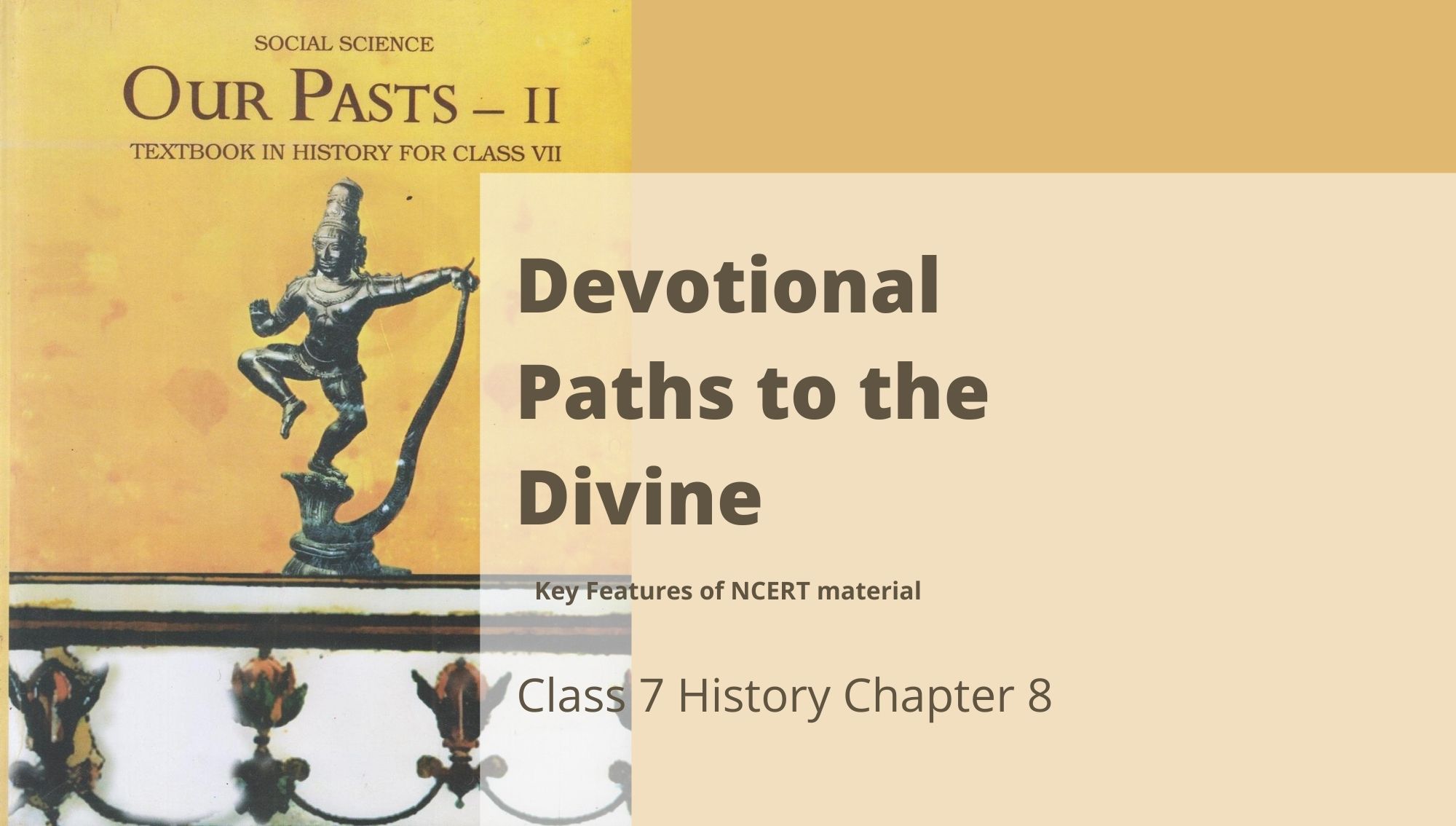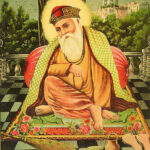Devotional Paths To The Divine: Class 7 History NCERT Chapter 8

Key Features of NCERT Material for Class 7 History Chapter 8 – Devotional Paths to the Divine
In the previous chapter 7 of NCERT class 7 history: Tribes, Nomads And Settled Communities, You studied what were tribes and tribal societies, and you learnt about pastoral nomads, and some tribes like The Gonds, The Ahoms etc. In this chapter of NCERT class 7 history: Devotional Paths To The Divine, You will study the different Bhakti and Sufi movements about devotion or love of God that have evolved since the 8th century.
Quick revision notes
In the eighth century, two new religious developments Sufism and Bhakti rose. Commitment to God without discriminati0n based on caste was instructed by the Bhakti and Sufi holy people. Both Sufism and Bhakti movements had a few common attributes and spread as popular movements at about a similar time.
The Idea of a Supreme God
- Before enormous kingdoms developed, various groups of individuals worshipped their own Gods and Goddesses. As individuals were united through the growth of towns, trade and empires, new thoughts started to create.
- The idea that every single person is not equivalent during childbirth emerged during this period.
- The possibility of a Supreme God who could deliver people from bondage and devotion or bhakti developed.
- Gods and goddesses revered in various zones came to be related to Shiva, Vishnu or Durga.
A New Kind of Bhakti movement in South India – Alvars and Nayanars.
- The seventh to ninth centuries saw the rise of another religious movement, driven by Nayanars (holy people dedicated to Shiva) and Alvars (holy people devoted to Vishnu).
- They were opposed to the Buddhists and Jains and preached vigorous love of Shiva or Vishnu as the way to salvation.
- So, the Nayanars and Alvars went here and there making perfect poems in praise of the gods cherished in the town they visited and set them up with good music.
- Whereas, The Chola and Pandya rulers constructed huge temples around shrines.
Reasoning and Bhakti
- Shankara, a philosopher, of Kerala pushed Advaita or the doctrine of the unity of the individual soul and the Supreme God which is a definitive reality. Ramanuja of Tamil Nadu supported that the best method for achieving salvation was through exceptional devotion to Vishnu.
Basavanna’s Virashaivism
- The Virashaivism movement was started by Basavanna and his companies Allama Prabhu and Akkamahadevi in Karnataka in the mid-12 century.
- Moreover, they contended strongly for equality of every person, contradicted Brahmanical thoughts on caste and treatment of ladies.
The Saints of Maharashtra
- Jnaneshwar, Eknath, Tukaram, Namdev, Sakkubai and the Chokhamela family focused on bhakti and worship of Vitthala (an avatar of Vishnu).
- A portion of these had a place with lower castes. They dismissed all types of ritualism, outward presentation of devotion and social differences dependent on birth.
Nathpanthis, Siddhas and Yogis
- Various religious groups that rose during this period reprimanded the custom and different parts of conventional religion and the social order, utilizing simple legitimate arguments.
- Among these were the Nathpanthis, Siddhcharas and Yogis.
Islam and Sufism
- Islam proliferated monotheism or devotion to one God. ‘
- It likewise dismissed idol worship. Muslim scholars made a holy law called Shariat.
- The Sufis dismissed the detailed codes of conduct requested by religious scholars.
- They looked for harmony with God, as a lover looks for his beloved with dismissal for the world.
- Amongst the Sufis of Central Asia were Ghazzali, Rumi and Sadi.
- Sufism presented numerous orders or silsilas of which the most known was the Shariat and Chisti Silsilas.
- The Chisti silsila was among the most influential. A long line of educators included Khwaja Moinuddin Chisti of Ajmer, Qutbuddin Bakhtiyar Kaki of Delhi, Baba Farid of Punjab, Khwaja Nizamuddin Auliya of Delhi and Bandanawaz Gisudaraz of Gulbarga.
New Religious Developments in North India
- The period after the thirteenth century saw another wave of bhakti movement in North India.
- This wave was driven by scholars like Tulsidas, Surdas, Kabir and Baba Guru Nanak
- This tradition likewise included saints like Dadu Dayal, Ravidas and Mirabai. Mirabai was completely devoted towards Lord Krishna.
- A one of a kind feature of most of these saints is that their works were formed in regional dialects and could be sung.

- Kabir mocked idol worship and had faith in one formless Supreme God with devotion as the way of salvation.
- Guru Nanak emphasized on the significance of one God and nam-japna, kirti-kama and vand-chhakna.The number of Baba Guru Nanak’s devotees expanded through the sixteenth century under his successors.
- Shankara was an advocate of Advaita or the doctrine of the unity of the individual soul and the Supreme God.
Bhakti and Sufi movements
Different sorts of Bhakti and Sufi movements advanced since the eighth century.
Prior to the rise of huge kingdoms, various groups of individuals revered their own gods and goddesses.
A few people likewise demonstrated their enthusiasm for the lessons of the Buddha or the Jainas.
Others felt pulled in to the possibility of a Supreme God. Such individuals looked for the way of Bhakti to move toward this Supreme God. Therefore, Shiva, Vishnu and Durga came to be perceived as supreme gods. Individuals started to worship them through elaborate ceremonies.
The seventh to ninth hundreds of years saw the development of new religious movements, driven by the Nayanars (saints devoted to Shiva) and Alvars (holy people committed to Vishnu) who originated from all castes including untouchables.
They scrutinized the Buddhists and Jainas and lectured enthusiastic love of Shiva or Vishnu as the way of salvation.
Huge temples were worked by the Chola and Pandya rulers between the tenth and twelfth centuries. Therefore, the Bhakti custom got connected strongly with temple worship.
Shankara
A Bhakti saint was an adherent of Advaita or the doctrine of the unity of the individual soul and the Supreme God which is the Ultimate Reality. He propagated renunciation of the world and adoption of the path of knowledge.
Ramanuja
another Bhakti saint was profoundly affected by the Alvars. As per him the best methods for achieving salvation was through extraordinary devotion to Vishnu.
Basavanna and his companions started the Virashaiva movement. This development started in Karnataka in the mid-twelfth century. The Virashaivas was against all types of ritual and idol worship.
The saint-poets of Maharashtra, for instance, Janeshwar, Namdev, Eknath and Tukaram inspired individuals through their tunes in Marathi. These saints dismissed all types of ceremony, outward display of devotion and social discrimination dependent on birth. They likewise dismissed the possibility of renunciation and liked to live with their families.
A few religious groups, like Siddhas, Nathpanthis and Yogis reprimanded the rituals and various parts of conventional religion and the castes. They supported the renunciation of the world. Also, they propelled individuals to lay in meditations on the formless Ultimate Reality and the acknowledgement of unity with it. They offered significance to yogasanas.
Sufis were Muslim spiritualists. They dismissed outward religiosity and stressed on love and dedication to God and comparison towards all other individuals.
Islam preached monotheism that is devotion to one God. It dismissed idol worship,
Muslim scholars made a heavenly law called Shariat. The Sufis dismissed the detailed ceremonies and codes of conduct requested by Muslim religious scholars.
The Sufis too made poems like the saint poets. Few of the exceptional Sufis were Ghazzali, Rumi and Sadi.
The Sufi saint created expound methods of training utilizing zikr (chanting of a name or sacred formula), contemplation, rags (dancing), sama (singing), breath control, discussions of parables and so on under the direction of a master or pir. Accordingly, rose the silsilas, a genealogy of Sufi educators. The Chishti silsila is worth referencing in this regard.
The Sufi teachers held their gatherings in their Khanqahs or hospices (places of rest for travellers). Here, they examined spiritual issues.
Sufi shrines are visited by dedicates from all backgrounds.
Another wave of Bhakti movement started in north India after the thirteenth century. This was an age when Islam, Brahmanical Hinduism, Sufism, different strands of Bhakti and the Nathpanths, Siddhas and Yogis had an effect on each other.
Kabir and Baba Guru Nanak dismissed every single orthodox religion. Others like Tulsidas and Surdas acknowledged existing practices and beliefs yet needed to make these available to all. Tulsidas’ composition, the Ramcharitmanas, written in Awadhi, is significant both as a statement of his devotion and as a literary work.
Surdas was a devotee of Krishna.
Dadu Dayal, Ravidas and Mirabai were some other significant saints of this custom.
Works by these saints were created in local dialects and consequently, they turned out to be well known.
We come to think about Kabir through his sakhis and pads, Kabir’s lessons depended on complete dismissal of the major religious traditions. He had confidence in a formless Supreme God and propagated that the main way to salvation was through Bhakti or devotion.
Guru Nanak underlined the significance of the love of one God. He demanded that caste, gender or creed was immaterial for accomplishing freedom. He utilized the terms nam, insan and dan for the embodiment of his preachings and lessons which really implied right worship, the welfare of others and purity of conduct.
Words that Matter
Virashaivism:
It was famous in Karnataka in the mid-twelfth century. Its devotees argued strongly for the equality of all individuals and against Brahmanical ideas about caste and the treatment of women.
Hagiography:
Saint’s life writings.
Vilthala:
Vishnu’s form.
Hospice:
Place of rest for travellers, especially one kept by a religious order.
Khanqah:
It means hospice.
Dargah:
It is a tomb of a religious saint in Muslim community known as a pilgrimage.
Langer:
A common kitchen where people from all different backgrounds eat together.
Dharamsala:
It is a sacred space developed by Baba Guru Nanak.
Khaba Panth:
The Sikh community.
Bhakti:
It implies devotion to God.
Sufi:
A Muslim mystic.
Silsila:
A genealogy of Sufi educators.
Salvation:
Getting free from the cycle of birth and death.
Shariat:
Holy law created by Muslim Scholars.
Gurmukhi:
A new script created by Guru Nanak.
1469-1539 – Baba Guru Nanak’s period.
1539 – Baba Guru Nanak passed away.
1604 – Guru Arjan assembled all the compositions written by the 3 successors of Guru Angad.
1606 – Execution of Guru Arjan.
1699 – The Khalsa was built by Guru Gobind Singh.



